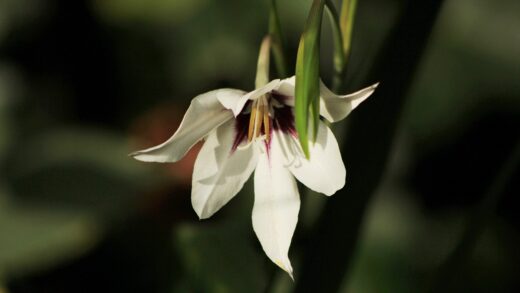Successfully wintering the dwarf iris is generally a straightforward affair, as these plants are inherently hardy and well-adapted to withstand cold temperatures, with most varieties being resilient down to USDA zone 4. Their survival strategy is stored within their fleshy rhizomes, which lie dormant just beneath the soil surface throughout the winter months. However, providing a little extra attention and preparation in the autumn can help to ensure their safe passage through the harshest conditions, protecting them from potential issues like frost heave and excessive moisture, and setting them up for a vigorous return in the spring.
The primary goal of winter preparation for dwarf irises is not to keep them warm, as they require a period of cold dormancy to trigger flowering, but rather to protect their shallowly planted rhizomes from environmental instability. The main threat in many winter climates is the cycle of freezing and thawing soil. This repeated expansion and contraction of the soil can gradually push or “heave” the rhizomes up out of the ground, leaving them exposed to desiccating winter winds and dangerously low temperatures. This is a particular risk for newly planted irises that have not yet developed a strong, anchoring root system.
Good drainage, which is crucial for irises year-round, becomes even more critical during the winter. In regions with wet winters, whether rainy or snowy, soil that does not drain well can become saturated with cold water. If the rhizomes sit in this cold, soggy soil for an extended period, they are highly susceptible to rot, even in cold temperatures. Therefore, the most important step in winter preparation happens at planting time: choosing a site with excellent natural drainage or amending the soil to create it.
A thorough autumn cleanup of the iris bed is another essential component of winter care. After the first hard frost has caused the foliage to die back completely, you should cut the leaves down to about two or three inches from the ground. This sanitation is vital because the dead foliage can provide a sheltered place for pests, such as the eggs of the iris borer, to overwinter. Removing this debris helps to break the life cycle of pests and also reduces the risk of fungal diseases carrying over from one season to the next.
Finally, the overall health of the plant going into winter has a significant impact on its ability to survive. A plant that has been well-cared-for throughout the growing season—provided with enough sun, not over-fertilized, and kept free from major pest or disease issues—will have a larger, healthier rhizome with more stored energy reserves. This robust health gives it the strength and resilience needed to endure the stresses of a long, cold winter and emerge with vigor in the spring.
More articles on this topic
The role of mulch in winter protection
Mulching can be a beneficial practice for wintering dwarf irises, but it must be done correctly and at the right time to be effective. The purpose of a winter mulch for irises is not to insulate the ground and keep it warm, but rather to stabilize the soil temperature and prevent the damaging freeze-thaw cycles that cause frost heave. By applying a layer of mulch, you help to keep the ground frozen once it freezes, providing a more stable environment for the dormant rhizomes.
The timing of mulch application is absolutely critical. You must wait until after the ground has frozen solid, typically after the first few hard frosts of the season. Applying mulch too early, while the ground is still warm, can trap heat and moisture around the rhizome, which can delay dormancy and create a perfect environment for rot and fungal diseases to develop. It can also provide a cozy winter home for voles and other rodents that may be tempted to feed on the iris rhizomes.
When choosing a mulch, opt for a light, airy material that will not become compacted and waterlogged over the winter. Excellent choices include pine needles, straw, or shredded leaves. These materials will insulate the soil from temperature fluctuations without trapping excessive moisture against the rhizomes. You should avoid heavy, dense mulches like compost or wet leaves, as these can hold too much water and may contribute to the decay of the rhizomes.
Apply a layer of your chosen mulch that is about two to three inches deep over the iris bed. This is generally sufficient to provide the desired temperature stabilization. In the early spring, as the threat of hard freezes begins to pass, it is equally important to remove the mulch in a timely manner. Rake the mulch away from the base of the plants as soon as new growth starts to appear. This allows the sun to reach and warm the soil and the rhizomes, and it ensures that the emerging foliage has access to light and good air circulation.
More articles on this topic
Special considerations for container-grown irises
Dwarf irises grown in containers or pots require more careful attention for wintering than their counterparts in the garden. The soil in a container is exposed to cold air from all sides, causing it to freeze much faster, deeper, and more intensely than the insulated soil in the ground. This can be fatal to the rhizomes, even for hardy varieties. Therefore, you cannot simply leave potted irises exposed to the full force of a harsh winter climate without providing some form of protection.
One of the most effective methods for protecting container-grown irises is to move the pot to a sheltered location. An unheated garage, a cold frame, or a shed are all excellent options. The goal is to keep the pot in a location that stays cold enough for the iris to remain dormant but protects it from the most extreme temperature drops and desiccating winds. The temperature in the storage location should ideally remain below 40°F (4°C) but above freezing for most of the winter.
If you do not have a suitable indoor storage space, you can insulate the pot. One technique is to place the pot inside a larger pot and fill the gap between them with an insulating material like straw, leaves, or bubble wrap. Another option is to group several pots together against a sheltered wall of your house and surround the entire group with burlap or straw bales. You can also “plant” the entire pot in the ground in a vacant spot in the garden, allowing the surrounding earth to provide natural insulation.
Throughout the winter, the soil in the container should be kept just barely moist, but never wet. You may need to check it once a month and provide a very small amount of water if it is completely dry, especially if you are storing it in a dry garage. In late winter or early spring, as temperatures begin to rise, you can gradually move the pot back out into the sun to encourage the plant to break dormancy and begin its spring growth cycle.
Preparing the plant for dormancy
The preparation for a healthy winter dormancy begins long before the first frost arrives. The care you provide to your dwarf irises during the summer and autumn directly impacts their ability to survive the winter. After the plant has finished flowering in the spring, it is crucial to leave the green foliage intact. The leaves continue to photosynthesize throughout the summer, producing the energy that is then stored in the rhizome. This stored energy is the plant’s life support system, fueling its survival through dormancy and its initial growth spurt the following spring.
As summer progresses into autumn, you should cease all supplemental watering and fertilization. This signals to the plant that it is time to slow down its growth and prepare for the dormant period. A late-season application of fertilizer, particularly one high in nitrogen, can be very harmful, as it may stimulate tender new growth that will be easily killed by the first frost, weakening the plant just as it needs to conserve its strength for the winter ahead.
The final step in preparing the plant itself is the autumn cleanup. Wait until the foliage has been completely killed back by a hard frost and has turned yellow or brown. At this point, the leaves have transferred all their energy back to the rhizome and are no longer serving a purpose. Use clean pruning shears to cut the dead foliage back to a height of two to three inches above the ground. Removing this debris is essential for pest and disease control, as it eliminates potential overwintering sites for iris borer eggs and fungal spores.
This autumn haircut not only improves garden sanitation but also helps to mark the location of your dormant irises so you do not accidentally disturb them during any off-season gardening activities. It provides a clean slate for the spring, ensuring that the new growth can emerge into a clean environment with good air circulation from the very start. This simple act of tidiness is a key part of setting the stage for a healthy and successful winter rest.
📷 Jerzy Opioła, CC BY-SA 4.0, via Wikimedia Commons


















